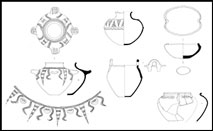Crossref Citations
This article has been cited by the following publications. This list is generated based on data provided by
Crossref.
Meadows, John
Rinne, Christoph
Immel, Alexander
Fuchs, Katharina
Krause-Kyora, Ben
and
Drummer, Clara
2020.
HIGH-PRECISION BAYESIAN CHRONOLOGICAL MODELING ON A CALIBRATION PLATEAU: THE NIEDERTIEFENBACH GALLERY GRAVE.
Radiocarbon,
Vol. 62,
Issue. 5,
p.
1261.
Cromartie, Amy
Blanchet, Claire
Barhoumi, Chéïma
Messager, Erwan
Peyron, Odile
Ollivier, Vincent
Sabatier, Pierre
Etienne, David
Karakhanyan, Arkady
Khatchadourian, Lori
Smith, Adam T.
Badalyan, Ruben
Perello, Bérengère
Lindsay, Ian
and
Joannin, Sébastien
2020.
The vegetation, climate, and fire history of a mountain steppe: A Holocene reconstruction from the South Caucasus, Shenkani, Armenia.
Quaternary Science Reviews,
Vol. 246,
Issue. ,
p.
106485.
Lau, Hannah
Proctor, Lucas
Gopnik, Hilary
and
Bakhshaliyev, Veli
2020.
Agropastoralism in middle bronze through early iron age Naxçıvan: Zooarchaeological and paleoethnobotanical data from Qızqala.
Journal of Archaeological Science: Reports,
Vol. 33,
Issue. ,
p.
102535.
Chazin, Hannah
2021.
Multi-Season Reproduction and Pastoralist Production Strategies: New Approaches to Birth Seasonality from the South Caucasus Region.
Journal of Field Archaeology,
Vol. 46,
Issue. 7,
p.
448.
Bedianashvili, Giorgi
Jamieson, Andrew
and
Sagona, Claudia
2021.
THE EARLY KURGAN PERIOD IN RABATI, GEORGIA: THE CULTURAL SEQUENCE AND A NEW SUITE OF RADIOCARBON DATES.
Radiocarbon,
Vol. 63,
Issue. 6,
p.
1673.
Manning, Sturt W
and
Birch, Jennifer
2022.
A CENTENNIAL AMBIGUITY: THE CHALLENGE OF RESOLVING THE DATE OF THE JEAN-BAPTISTE LAINÉ (MANTLE), ONTARIO, SITE—AROUND AD 1500 OR AD 1600?—AND THE CASE FOR WOOD-CHARCOAL AS A TERMINUS POST QUEM.
Radiocarbon,
Vol. 64,
Issue. 2,
p.
279.
Von Suchodoletz, Hans
Kirkitadze, Giorgi
Koff, Tiiu
Fischer, Markus L.
Poch, Rosa M.
Khosravichenar, Azra
Schneider, Birgit
Glaser, Bruno
Lindauer, Susanne
Hoth, Silvan
Skokan, Anna
Navrozashvili, Levan
Lobjanidze, Mikheil
Akhalaia, Mate
Losaberidze, Levan
and
Elashvili, Mikheil
2022.
Human-environmental interactions and seismic activity in a Late Bronze to Early Iron Age settlement center in the southeastern Caucasus.
Frontiers in Earth Science,
Vol. 10,
Issue. ,
Smith, Adam T.
2022.
Civilization Machines: Value and Recognition on the Armenian Highland from the Bronze Age to Today.
Scottish Archaeological Journal,
Vol. 44,
Issue. 1,
p.
64.
Manoukian, Nyree
Whelton, Helen L.
Dunne, Julie
Badalyan, Ruben
Smith, Adam T.
Simonyan, Hakob
Rothman, Mitchell S.
Bobokhyan, Arsen
Hovsepyan, Roman
Avetisyan, Pavel
Evershed, Richard P.
Pollard, A. Mark
and
Biehl, Peter F.
2022.
Diverse dietary practices across the Early Bronze Age ‘Kura-Araxes culture’ in the South Caucasus.
PLOS ONE,
Vol. 17,
Issue. 12,
p.
e0278345.
Rose, Helene Agerskov
Müller-Scheeßel, Nils
Meadows, John
and
Hamann, Christian
2022.
Radiocarbon dating and Hallstatt chronology: a Bayesian chronological model for the burial sequence at Dietfurt an der Altmühl ‘Tennisplatz’, Bavaria, Germany.
Archaeological and Anthropological Sciences,
Vol. 14,
Issue. 4,
Erb-Satullo, Nathaniel L.
and
Jachvliani, Dimitri
2022.
Fortified Communities in the South Caucasus: Insights from Mtsvane Gora and Dmanisis Gora.
Journal of Field Archaeology,
Vol. 47,
Issue. 5,
p.
305.
Lindsay, Ian
Greene, Alan F.
Marshall, Maureen E.
Badalyan, Ruben
Cromartie, Amy
Azatyan, Karen
Aghikyan, Levon
Khatchadourian, Lori
Mkrtchyan, Arshaluys
and
Smith, Adam T.
2022.
The Project ArAGATS Kasakh Valley Archaeological Survey, Armenia: Report of the 2014–2017 Seasons.
American Journal of Archaeology,
Vol. 126,
Issue. 2,
p.
261.
Otárola‐Castillo, Erik
Torquato, Melissa G.
and
Buck, Caitlin E.
2023.
Handbook of Archaeological Sciences.
p.
1193.
Ricci, Andrea
Jalilov, Bakhtiyar
Fiori, Stefania
Erkul, Ercan
Kneisel, Jutta
Fischer, Simon
Raese, Hendrik
and
Rabbel, Wolfgang
2024.
Kurgan Phenomenon in the Southern Caucasus: Results of an Interdisciplinary Multi‐Method Remote Sensing Survey Along the Kurekçay Valley (Goranboy Province, Western Azerbaijan).
Archaeological Prospection,
Rose, Helene Agerskov
Meadows, John
and
Biehl, Peter F.
2024.
Dividing time—An absolute chronological study of material culture from Early Iron Age urnfields in Denmark.
PLOS ONE,
Vol. 19,
Issue. 5,
p.
e0300649.





